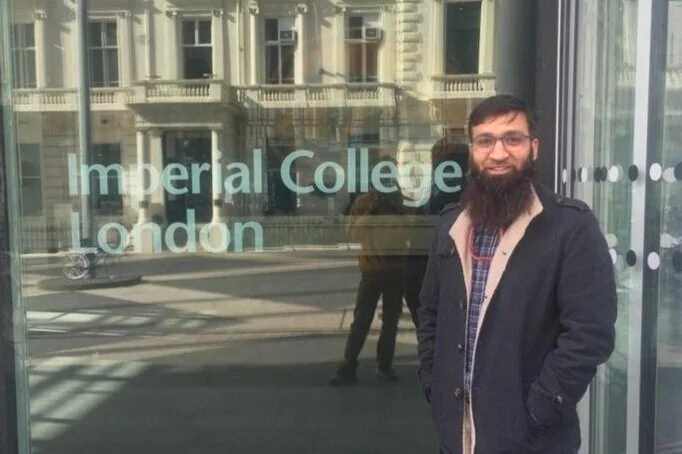Alumnus Update: Anmol Manohar
Anmol Manohar is a 2013 scholar. He is an aircraft designer, interested in pushing the boundaries in aviation to address today's challenges in sustainability and mobility. Previously a research and development Engineer with Rolls Royce, he is currently working with Blue Bear Systems Research Ltd to develop solutions for the emerging urban air mobility market.
I am currently an aircraft designer and technical lead for urban air mobility at Blue Bear Systems Research. Blue Bear is a UK based aerospace company that designs and builds unmanned aerial vehicles. Previously I worked as a R&D engineer at Rolls Royce aero engines in the UK.
1904: Wright Brothers
50 years later, 1950: Boeing 707
It still astonishes me every day how much progress humanity as made in the field of aviation since the Wright Brothers first flight in 1904. Most people flying across continents today ignore the fact that they are sitting in an engineering marvel, travelling 1000s of miles at nearly sonic speeds in only a few hours. Only 200 years back this would have sounded as impossible as warp drives and anti-gravity machines seem to us today. However, most aerospace engineers like myself do not fantasise about working in commercial jet transport. It is growing commercially, but stagnant technologically. All innovations are driven to reduce cost and emissions rather than pushing the boundaries of physics.
50 years later, 2010: Boeing 787
Aviation fascinated me quite early in life. As a 12-year-old kid watching a Sea Harrier take-off vertically like a helicopter from the Indian Navy aircraft carrier Vikrant, and then fly away like a Jet Fighter, I felt I watching a Star Wars scene in real life! The Sea Harrier emerged in the 1960s in the fringes of aerospace, from the world of radical aircraft development and novel aircraft design. This small community within the aerospace industry is where game changing innovations happen and I have been fortunate to be a part of this community for the last few years, first at Rolls Royce Aero Engines and now at Blue Bear Systems Research.
The challenge of novel aircraft design involves using the state-of-the-art technologies and innovations available today and imagining what flying machines are possible with them. Today's new technologies are electric propulsion, fuel cells, novel materials, artificial intelligence and autonomy amongst others. As an aircraft designer, I have to absorb all these different disciplines and bring them together to create a new aircraft. I am fortunate that my work (in novel electric aircraft) also has positive environmental impact, as these vehicles enable zero emission sustainable mobility. The world wants to travel across oceans without emitting any CO2 emissions, and this is the challenge of my generation's engineers. Pioneers like Wright Brothers will have to emerge in the next 20 years to make this possible.
I currently work in the field of urban air mobility, everything from small drones transporting food to air taxis hauling 4-5 passengers across a city. If the traffic situation in many cities isn’t bad enough today, based on current trends, it is estimated that in a few decades, 2/3rd of the Earth's population will live in cities. If our city transportation system remains 2 dimensional, our cities will be clogged. Urban air mobility is one of the promising solutions, amongst others such as the hyperloop and driverless cars. The Urban Air Mobility market is in the experimental period now, ripe for innovation with lots of unusual configurations, but I expect (quite realistically) in 10 years, some designs will mature and enter the market on a mass scale. Hopefully amongst those will be something I work on today.
Below are some of the projects I have worked on.
The Rolls Royce eVTOL is a 4-seat hybrid electric aircraft designed to fly between city pairs (London-Paris, New York-Washington) in an hour. The unique element of this design is that it can take-off and land vertically, so it could shorten travel between cities by 3x and spread economic wealth around a major metropolis. The design team that I led consisting of experienced Rolls Royce engineers went beyond just rendering and analysis; we built prototypes and proved its viability in realistic conditions.
Rolls Royce eVTOL: 4 seat inter-city transporter
The Vision Volante was a collaborative design project between my team at Rolls Royce and the vehicles designers at UK's luxury car manufacturer Aston Martin. The vision for this project was to imagine a personal air vehicle for James Bond (all JB films feature a new Aston Martin concept), and it is fair to say our team didn’t disappoint. The Aston Martin team brought their design expertise in form and style, while my team brought the engineering knowledge necessary to produce a feasible flying vehicle. It’s still not realisable with today's technology but should be possible in 10 years. The concept release at the world's largest airshow, Farnborough Airshow 2018, was featured on BBC and other news outlets.
Vision Volante: Aston Martin-Rolls Royce personal luxury air vehicle
The third aircraft is called 'Micro-Rapter'. It is an entry level aircraft for the amatuer pilot/drone enthusiast. I along with 4 other engineers, designed this aircraft for the Royal Aeronautical Society Light Aircraft Design Competition 2018 and we were one of the 3 winning entries. A single seat aircraft (only 120kgs in weight), it was designed for ease of use (fits into a small trailer van), low cost (equivalent to a small car) and easy to fly (through an ipad interface). The design had lots of novel ideas. Amongst them was the fact that the aircraft had no control surfaces or moving.
Micro-Raptor: Personal electric leisure aircraft












